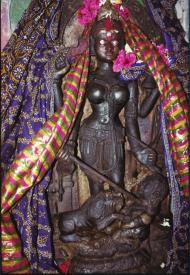 |
 |
The Path of the Yogini The Living Goddess < back to The Path of the Yogini
In 1998 I experienced God in the body of a young Nepalese girl during a visit to Kathmandu. A series of synchronistic experiences during a backpacking journey through Southeast Asia had led me to this Himalayan Valley, but I was unprepared for the life altering effect receiving a glance from her would have on me. Prior to this fateful encounter I had spent almost a decade researching Goddesses from the ancient world: Greek Hecate, Navajo Changing Woman, Yoruban Yemoja, Egyptian Isis, Sumerian Inanna, and others. I was aware of the blossoming feminist spirituality movement focused on reclaiming a divinity that looked more like my female self. However, at that time in my life, these Goddesses had more of an abstract transcendent quality to them. Yes, in theory I agreed that She is the Earth Mother and the Cosmos, but I had not yet fully understood that to mean God truly is on this earth plane and manifests not only through the earth, but through all the earth’s creatures, even the bodies of little girls. As a child and teen, God the Father never resonated with me—in fact, the notion of a white bearded male god in the sky with all his judgments around what was sinful and how girls should behave had never felt real to me. Growing up in a household of domestic violence and abuse, that God seemed too similar to my tyrannical father, who had returned from the Vietnam War when I was 18 months old. My childhood consisted of endless battles and humiliations and a never-ending series of injustices. My relationship with my grandmother, as well as a rich inner life, connected me to the spirit world and created a lifeline for me. However, when I became severely ill at the age of 20, first with Guillian Barre and then endometriosis, I grew tired of battling with my body, the medical system, and the demons of my past. I no longer was sure what or who to believe in. Fortunately, my encounter with the Kumari led me back to a deep and felt sense of power within. The Kumari is a Living Virgin Goddess, who resides in a temple in the center of Kathmandu. During the time she is in office, generally between the ages of 2-13, she acts as a living oracle, consulted by the King and other government officials before any important decision is made. The tradition of the Kumari goes back about 500 years and her initiation and installation process is similar to the process of recognizing lamas in Tibet. Not just any girl can become the royal Kumari. Despite this being a Hindu tradition, she must come from a Buddhist caste and she must pass a series of tests to prove that she is an incarnation of a fierce and fearless Goddess. The Kumari is believed to be possessed by the Goddess Durga, the great Mother of Strength and Justice, Remover of Fear and Difficulty. In her 5th century myth, Durga slays demons of violence, corruption, ignorance, and disease restoring peace and harmony to her devotees and the world around them. Not only does Durga confront the adversarial energies that attempt to strip us of our dignity and rob us of any sense of inner peace, but in her form as the Kumari, She is the Goddess to whom women with menstrual disorders and illness go. I did not learn about the Kumari’s healing powers around menstruation until two years after my first meeting with her. However, considering my own painful menstrual history, it is no wonder that I was instinctively first drawn to her temple in Kathmandu. The Kumari’s healing powers over the domain of menstruation are curious and paradoxical—this young girl is said to maintain the Goddess’ power only until she menstruates. According to the orthodox tradition, the "polluting" nature of her blood, whether through a cut or her menarche, is said to dispel the power of the Goddess from her body. There are theories around why menstrual blood is "polluting" and inauspicious, but underlying the cultural negativity around menstruation in both east and west is a fear of the wild, untamable, and natural female force that will not simply "go away." For years I have wondered if the worship of the Kumari, God in a female virgin form, points to earlier practices where females were honored and respected, or if it is yet another example of the way religion and culture glorify the pre-pubescent female and demonize and attempt to control the natural functions of the female body especially those related to our sexuality and reproductive cycles? The Kumari is called the Virgin Goddess. Virgin actually means whole unto herself. When I consider European philosopher, Luce Irigaray’s writings on virginity and the language around our first sexual act –to lose one’s virginity, I wonder why choosing to have sex, or even the natural occurrence of menarche culturally indicates some sort of sacrifice or loss of innocence, purity, and ultimately power? How can we maintain that sense of wholeness, the full divine power of Goddess within for which the Kumari is honored, when we are young girls, pubescent teens, and mature women? The connection between the onset of puberty and this young girl’s discharge from spiritual office, the ways that she struggles to assimilate into Nepalese culture after having been sheltered for the majority of her life are problematic; and an issue that Human Rights groups in Nepal have taken on. It is complex and Tassia Kobylinska’s film, Kumari: Living Goddess of Nepal, is a good reference for those who want to learn more about the Kumari. However, what strikes me about the Kumari is the power this young girl undeniably holds as well as the idea of God being worshiped and honored in a young girl. When I think back to my own life, my puberty and menstruation also triggered a whole new slew of problems at home as my father called me a slut and accused me of becoming pregnant before I had even kissed a boy. He grounded me for wearing earrings that dropped below my earlobes, or any hint of make-up, so threatening was my budding sexuality and the loss of patriarchal control and ownership he felt over my body. Consequently, due to years of psychological, sexual, and physical abuse, from the onset of my menstruation I suffered from dysmenorhea and later endometriosis. The pain I experienced was beyond excruciating. It was a hell realm where all my anger, pain, and fear would surface; where I would blame my body for betraying me instead of being able to love my body and to acknowledge the ways I had been wounded and betrayed by my father, by the poor choices I had made in many of my sexual relationships, and by the debilitating and unrealistic depictions of femininity in patriarchal culture. Battling endometriosis I felt completely disempowered, ashamed, and paralyzed by my ill health and painful struggles that lasted over a decade. Yet, paradoxically, this illness was the key to coming back into my power. It lead me to Nepal for healing, and to God in the form of young girl, the Kumari, whose powerful glance and blood red dress was so intriguing and captivating that I have been inspired to research and teach about the mythologies, rituals, and incarnation of the divine female in South Asia for the past eleven years. I saw myself in the Kumari, and consciously grieved the loss of my power, confidence and respect for self with my coming of age as so many of us do. After my first encounter with the Kumari I turned to classical tantric practices such as yoga, meditation, chanting, and exploring Goddess in the Kaula, Shakta and Tantra traditions of South Asia. It took almost a decade of commitment to self-empowerment and healing, but I no longer suffer from endometriosis. I have learned invaluable lessons about listening to my body, turning within, and recognizing my own inherent divinity. When I bleed I feel empowered with a deep connection to Goddess. I feel grateful for my female body and this monthly opportunity to carve out some time for myself to go within and listen to what my body has to say. Essential to healing the pain I felt around my menstruation, and being female in a patriarchal world, has been this recognition of the divine in the body of a little girl and in all women. I wonder how many other females are in need of a glance of recognition, a sacred witness who mirrors back the strength and wisdom of our femaleness? Despite our many differences, the one thing all females born female share is our monthly blood. Women bleed. What would happen if we all became Kumaris, Living Virgin Goddesses, "whole unto our self" in partnership or not? What if instead of allowing patriarchal religion and culture to tell us our power leaves us when we start our menses, we consciously claimed and celebrated the inherent power of our blood and our divinity?
Laura Amazzone is an author, teacher, jewelry artist, and Yogini. She completed her master’s degree in philosophy and religion, with an emphasis in women’s spirituality at the California Institute of Integral Studies in 2001. Her book, Goddess Durga and Sacred Female Power (Baltimore: Hamilton Press, 2010), explores the millennia-old rituals and manifestations of the Goddess in South Asia and honors female creative & sexual power as a divine force. Laura teaches classes and workshops on Goddess spirituality and Eastern religious traditions and is adjunct faculty in the Yoga & Philosophy program at Loyola Marymount University in Los Angeles. She has published numerous articles discussing myth, ritual, adornment, and the significance of South Asian Goddesses as divine models of female empowerment. She blogs for the Religion section of the Huffington Post. She lives in Venice, California. www.lauraamazzone.com < back to The Path of the Yogini
|
|||
Home | About Us | Features | Ask
Our Team | Inspiration
& Practice | Women of Vision | Resources
Copyright 2011 Feminist.com. All rights reserved.
